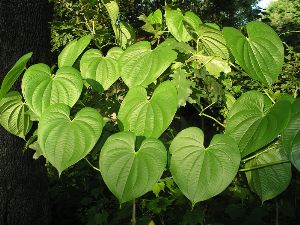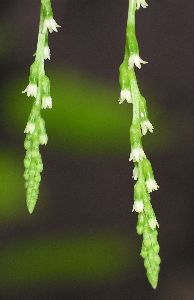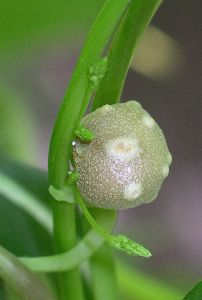Air Potato
by Valerie (September 24, 2004)
 Considered an invasive plant species in warmer climates, the air potato (Dioscorea bulbifera) is a delightful vine for our gardens here in Austin. It is a borderline species in this area and does not do particularly well, but can grow enough to add a little variety to shady gardens. The species is native to tropical Asia and Africa.
Considered an invasive plant species in warmer climates, the air potato (Dioscorea bulbifera) is a delightful vine for our gardens here in Austin. It is a borderline species in this area and does not do particularly well, but can grow enough to add a little variety to shady gardens. The species is native to tropical Asia and Africa.
Not related to potatoes at all, the air potato is named for the aerial bulbils that form at the base of many of the leaves during the latter part of summer. These nodules can range in size from about 1/2 inch up to several inches in diameter, but those on our plants never get bigger than about 1 inch. The vines themselves can reach dozens of feet in length in favorable climates; here they usually get no longer than about 10 feet. Being vines, the plants do need something on which to grow, but any small shrub, tree or fence will do. Air potato vines climb by twining around things, not by producing tendrils like grape vines.
I've found that the best way to grow the air potato is to obtain the biggest bulbils that I can find when I visit Florida. Because the species is a problem plant in that state, I'm sure they would love it if everyone who visits would remove as many as possible. When these are planted in our gardens, they produce large and vigorous vines the first few years, gradually declining in both size and growth rate until they die out. Needing a moderate amount of water, the leaves of the vine are the big attraction. They are glossy and heart-shaped and can get to be over 6 inches long, although they are subject to caterpillar damage early in the year. Later in the summer, a particularly strong vine will actually flower, but the blossoms are small and easy to miss. Upon close inspection, the flowers are quite attractive and remind me of dangling earrings with tiny jewels. I've never seen any sort of seed produced after the flowers bloom. Although extremely hot temperatures do not seem to affect the foliage, extended drought will kill the vines, so they need a bit of supplemental watering. The vines also do best with some shade. Grown amongst other shrubs and vines, the air potatoes add the pleasant exotic appearance of a house plant to our gardens with a minimum amount of care. |

 The large bulbil, which I usually bury right beneath the soil gets "used up" and eventually only a hollow shell remains at the base of the plant. The first year they produce little potatoes and these will sprout the next year but only grow a few leaves at best. Each year, the air potato vines sprout later in the growing season, as if they are shocked back by the cold winter and take a long time to recover. Because of this late start on subsequent years, the vines have less time to grow before they die back in the fall, usually not even waiting for a hard freeze.
The large bulbil, which I usually bury right beneath the soil gets "used up" and eventually only a hollow shell remains at the base of the plant. The first year they produce little potatoes and these will sprout the next year but only grow a few leaves at best. Each year, the air potato vines sprout later in the growing season, as if they are shocked back by the cold winter and take a long time to recover. Because of this late start on subsequent years, the vines have less time to grow before they die back in the fall, usually not even waiting for a hard freeze.